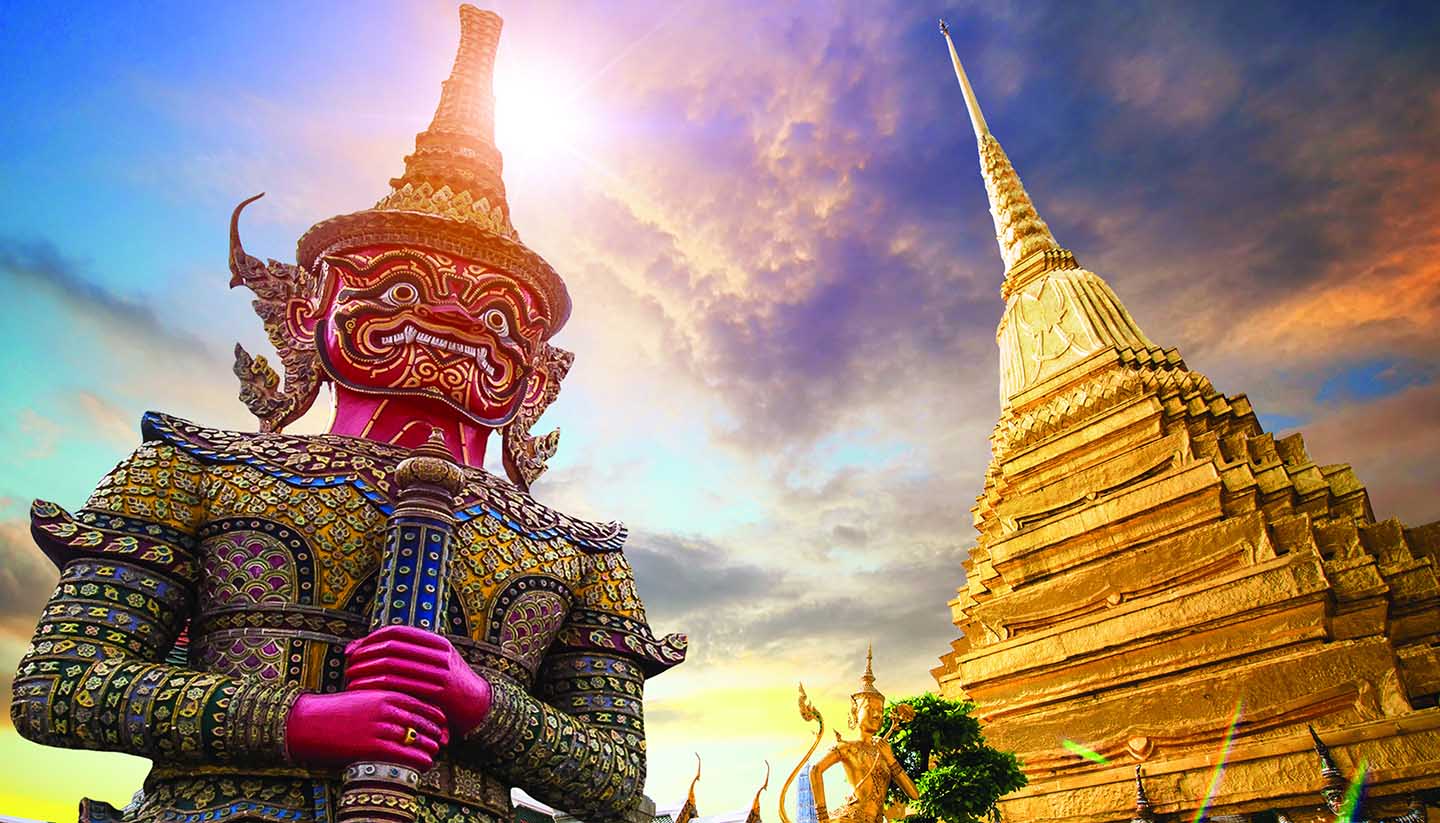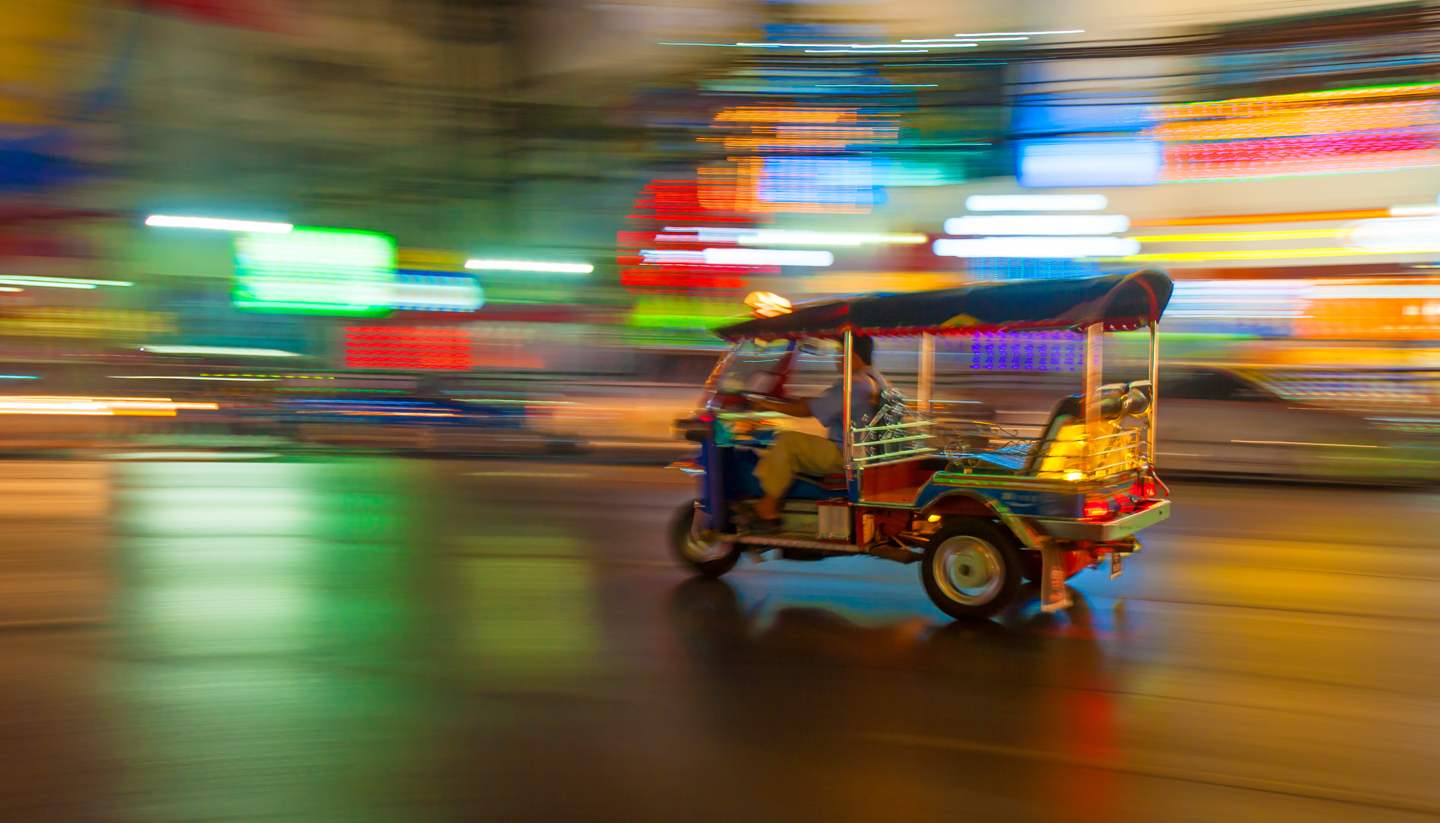Things to see in Bangkok
Attractions
Grand Palace
A glittering walled complex that houses several palaces and temples, most ornately decorated with tiles and ceramics, the Grand Palace dates back to 1782 when Bangkok was founded as the new capital of Thailand.
The most important spot is Wat Phra Kaeo, the holiest of all Thai temples, where the sacred tiny Emerald Buddha rests – covered in jade, not emeralds. The rest of the complex houses a mix of Chinese gates, giant yaksha (demon) statues, pretty courtyards and a kilometre-long mural depicting scenes from the Hindu epic Ramayana. There is a strict dress code and visitors wearing shorts, mini-skirts, sleeveless shirts or flip-flops will need to hire trousers and plastic shoes at the entrance.
Address: , Na Phra Lan Road, Bangkok,Telephone: +66 2 623 5500.
Opening times:
Daily 0830-1530.
Website: http://www.palaces.thai.netAdmission Fees:
Yes.
Disabled Access: YesUNESCO: No
Wat Phra Kaew (Temple of the Emerald Buddha)
This is Thailand's most sacred Buddhist temple, and you'll notice the golden golden chedis dominatinf the skyline as you arrive at its outer walls. The Emerald Buddha is carved from a single jade stone.
Address: , Na Phra Lan Road, Phra Nakhon , Bangkok, 10200Telephone:
Opening times:
Daily 0830-1530
Website:Admission Fees:
Yes
Disabled Access: NoUNESCO: No
Wat Pho (Temple of the Reclining Buddha)
Occupying a 20-hectare (50-acre) site next to the Grand Palace, Wat Pho is Bangkok’s oldest temple, dating back to 1688 and the reign of King Petraja of Ayutthaya. Note the dress code: no shorts and shoulders should be covered.
Wat Po features one of Thailand's most spectacular sights, the 46m-long (150ft) and 15m-high (72ft) Reclining Buddha. Gold-plated and inlaid with mother-of-pearl on the soles of the feet, the statue serves to illustrate the passing of Buddha into Nirvana, the state of absolute blessedness.
Visitors can wander amongst the peaceful rock gardens, chapels, cloisters and stupas. The temple is also renowned for its teaching of herbal medicine and visitors can book traditional massages at its Thai Traditional Medical School.
Address: , 2 Sanamchai Road (main entrance Soi Chetuphon), Bangkok,Telephone: +66 2 226 0335.
Opening times:
Daily 0800-1830.
Website: http://www.watpho.comAdmission Fees:
Yes.
Disabled Access: YesUNESCO: No
The Jim Thompson House
This is the former residence of Jim Thompson, an American who lived in Bangkok after WWII until his mysterious disappearance in Malaysia in 1967. A businessman, traveller and art collector, he completely revived the Thai silk-weaving industry and his traditional Thai-style house, which is over 200 years old, is now a museum showcasing his collection of Asian artefacts, textiles and Thai paintings.
The house is a complex of six traditional Thai teak structures and can only be visited on a guided tour. There is also a shop and the Jim Thompson Art Centre, which sits above the house, is a gallery space for temporary exhibitions.
Address: Rama 1 Road, 6 Soi Kasemsan 2 (Song), Bangkok,Telephone: +66 2 216 7368.
Opening times:
Daily 0900-1800.
Website: http://www.jimthompsonhouse.comAdmission Fees:
Yes.
Disabled Access: YesUNESCO: No
National Museum
One of the region’s largest and most comprehensive museums, Bangkok’s National Museum houses a vast collection of artefacts from the Neolithic period, royal funeral chariots and the Phra Sihing Buddha in the ornate Buddhaisawan chapel - Thailand’s second holiest image after the Grand Palace’s Emerald Buddha.
Work began on the museum building in 1782, so its traditional Thai design is fascinating in its own right. Due to its size, one visit isn’t always enough and if time is short, don’t miss Tamnak Daeng, a lovely teak pavilion housing personal royal belongings. Free guided tours in English are led by volunteers at 0930 on Wednesdays and Thursdays and are highly recommended.
Address: , Na Phrathat Road, Bangkok,Telephone: +66 2 224 1333.
Opening times:
Wed-Sun 0930-1530.
Website: http://www.thailandmuseum.comAdmission Fees:
Yes.
Disabled Access: YesUNESCO: No
Wat Arun (Temple of Dawn)
Located on the Thonburi side of the Chao Phraya River, opposite Wat Pho, is Wat Arun and its five soaring spires. Its towering central 79m-high (259ft) prang has made this temple a distinct landmark along the river and you can climb up to a certain point for excellent views over the Chao Phraya River, especially at sunset.
The temple was actually the first home of the Emerald Buddha before it was transferred to Wat Phra Kaeo at the Grand Palace in 1785. So-called after Aruna, the Indian God of Dawn, the temple represents Mount Meru, the centre of the world and home of the Gods in Buddhist cosmology.
Address: Wat Arun, 158 Wang Doem Road, Bangkok,Telephone: +66 2 891 2185.
Opening times:
Daily 0830-1730.
Website: http://www.watarun.netAdmission Fees:
Yes.
Disabled Access: YesUNESCO: No
Suan Pakkad Palace Museum
The former residence of Prince and Princess Chumphot, one of Thailand's leading art collectors, Suan Pakkad Palace contains a host of their art and antiquities passed down the generations. Eight traditional wooden Thai houses, brought to Bangkok from around the country, are set in one of the loveliest gardens in the city, each one containing a varied assortment of artefacts from painted pottery to Buddha images.
Don't miss the Lacquer Pavilion, its wall depicting the Ramayana and the life of Buddha. The grounds also house the royal barge, Kao Kung Bayam. The Ban-Chiang Museum and Marsi Gallery, which host year-round art and culture exhibitions, are set in the Chumbhot-Pantip Centre of Arts.
Address: Rajathevi, Sri Ayudhaya Road, Bangkok,Telephone: +66 2 245 4934.
Opening times:
Daily 0900-1600.
Website: http://www.suanpakkad.comAdmission Fees:
Yes.
Disabled Access: YesUNESCO: No
Royal Barges National Museum
Rarely used by the royal family these days, several historic royal barges are now preserved in the Royal Barges National Museum on the Thonburi side of the Chao Phraya River.
The eight narrow boats on display are intricately gilded and each need between 50 and 60 rowers to take their oars. The figure on the bow of each boat signifies whether it carries the King and Queen or other members of the royal family. The most important barge is the Suphannahong. Made from one piece of timber, and with a golden swan figurehead, it is exclusively used by the King.
Address: , Khlong Bangkok Noi, Bangkok,Telephone: +66 2 424 0004.
Opening times:
Daily 0900-1700.
Website:Admission Fees:
Yes.
Disabled Access: YesUNESCO: No
Ban Kamthieng (Kamthieng House)
This 200-year-old, Lanna-style teak house was built on the Ping River in 1848 and transported south from Chiang Mai to be reconstructed in Bangkok. Once owned by a countryside family, it has now been set up as an ethnological museum by the Siam Society. Showing the simplicity of rural life in northern Thailand during the last century, it contains a collection of traditional implements such as fish traps used by farmers and rice field fishermen.
Other features include a short film on Lanna Thai village life, courtship and spirit music on the veranda, and a short film showing a northern grandmother preparing a traditional dish in the kitchen.
Address: Sukhumvit 21, 131 Asoke Montri Road, Bangkok,Telephone: +66 2 6616 4707.
Opening times:
Tues-Sat 0900-1700.
Website: http://www.siam-society.orgAdmission Fees:
Yes.
Disabled Access: YesUNESCO: No
Erawan Shrine
On the corner of a busy junction, opposite the Central World Plaza shopping mall in downtown Bangkok, is the revered Erawan Shrine. Thais flock to this homage to Brahma, the Hindu god of creation, and his elephant, Erawan, which looks best at night when the shrine is illuminated. At the entrance, traders sell incense sticks and garlands, which worshippers place in the shrine.
On occasion, visitors can catch traditional Thai dancers and even an orchestra, both of whom are often hired by worshippers who want their prayers answered. For an aerial view of the shrine, head to the elevated walkway of the BTS Skytrain above.
Address: , On the corner of Ploenchit Road and Ratchadamri Road, Bangkok,Telephone:
Opening times:
Daily 24 hours.
Website:Admission Fees:
Yes.
Disabled Access: YesUNESCO: No
Lumphini Park
There's not much green space in Bangkok but Lumphini Park (also called Suan Lun) offers welcome relief from the hustle and bustle of the city. Once the private land of King Rama VI, this became Thailand’s first public park when he donated it to the city. It was re-landscaped to host Thailand’s first Expo in 1920s, which failed to happen as the king passed away. The park later opened for public use in 1952.
During the cooler months from December to February, the Bangkok Symphony Orchestra host a series of free concerts in the park on Sundays featuring guest singers. Other activities include boating on the lake, al fresco t’ai chi and jogging.
Address: Pathum Wan, Rama IV Road, Bangkok,Telephone: +66 2 252 5948.
Opening times:
Daily 0500-2100.
Website:Admission Fees:
No.
Disabled Access: YesUNESCO: No
Tourist Offices
Tourism Authority of Thailand (TAT)
Address: Rajatevee, First Floor, 1600 New Phetburi Road, Bangkok,Telephone: +66 2 250 5500.
Opening times:
Mon-Fri 0830-1630.
Website: http://www.tourismthailand.orgThe TAT Call Centre (tel: 1672, in Thailand only) is open daily 0800-2000.
Tourist passes
There are no official sightseeing passes, but visitors can buy one-day passes for unlimited travel on the Chao Phraya Tourist Boat where an on-board guide suggests sights and stops of interest.



